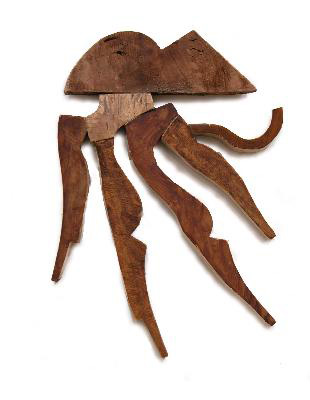The wind’s memory KEITH LONG "LES SYLPHES"
- lundi 13 septembre 2010, par Florence Valérie ALONZO

Voir en ligne : www.keithlong.com/
“Let me give you a brief history : Originally, I was an abstract painter, and during the fifties and sixties, worked in the mode of the New York Abstract Expressionists. After my school years, I became interested by Minimalism, and slowly turned to sculpture as my work became simpler and simpler. The difficult part was to search out the essential form, and my work became more and more basic.
“I began to build forms using polyester resin and fiberglass, and finally, I was working with an optical film which produced a reflection surrounded by a rainbow of color – and I thought : these objects that I’m making are very beautiful, but completely cold and impersonal, and they contain no emotional content.
“I went through a period of doubt and questioning. I was trying to make a new aesthetic, and I began with the question, what is it that produces emotion in the first place ?
“When you look at a seashell, you can imagine the life of this little animal, the incidents and the traumas of its existence - the history of this little organism is recorded in its physical remnants. This idea really excited me : it was like looking into someone’s face. I decided to try to make a sort of portrait of these natural objects – a feather, for example, found on the ground, carries with it the traces of tiny incidents that occurred to the bird. These moments still live in the object, and it is possible to rediscover a window into its nature. Like fossils, which are traces of a long lost life. One could form an empathy with these objects. In 1972 – 75, I went through a personal renaissance, drawing leaves and butterflies.
“And, in the course of my interest in these objects that I was reconstructing, I realized that when I found an object in the road or at the beach, I was first attracted to the texture. When I began to reconstruct them, I was offering these objects a renaissance as well !
“My sculptures are not three dimensional. Placed on the wall, they dictate how one views them. Perhaps this comes from the time that I was a painter, but I like to place my work on the wall – this way, I can control the direction and the distance from which the pieces are seen. Perhaps it is more formal, but it means that the work is viewed frontally.
“A word about the Sylphe series, a group of works which, in part, derives from the preceding series, entitled Wind. Both are feminine forms. The Wind series are being affected by an exterior force : they are being influenced by something else. In the Sylphs (the mythological reference is secondary, by the way), the objects are being driven or formed by interior forces. The primary thing for me is not a reference to nature ; it is the form and the space of these objects.
“It is essential to me that I respect the integrity of the materials with which I work. For me, the material is a product of a past time – it harkens back to another situation. I care about the objects that I find – it would be a sacrilege if I didn’t. I deeply want to make something which is uniquely mine, but which, at the same time, allows the original material to continue to exist. It concerns, as I’ve said, empathy between me and the material.
“My most anecdotal pieces are the Ready to Wear series – they are more light-hearted and amusing in character. The wood starts to resemble draped fabric.
“The titles for my work are only supplementary additions ; they are hopefully useful for the spectator to gain an entry to the work. They are not an explanation, only a point of departure.
“Everyone finds a certain sympathy with bits of nature that one finds. It’s universal – everyone finds something personal to relate to in nature, and my work is no more complicated than that : I find an object, pick it up, bring it back to the studio – sometimes, it sits for a long while before I rediscover it. If I’m at a good moment, I have a reaction with its form or texture, I put two pieces together and something happens. By chance, a moment of liaison occurs, and I’m receptive to the nature of this object – but these are rare moments.
“I love being in a natural setting. My spirit is free to think, to breathe. I do a lot of drawings in Pere Lachaise Cemetery. In the States, I have a little cabin which is next to a river. The sounds of the water passing between the rocks wash my thoughts.
“My works have an independent life, a personal identity all their own – their production happens naturally : they themselves dictate the rest of their history. The magic of creation – that’s the art. It’s impossible to give a definition to this kind of interaction. The moment that I work towards is when the piece begins to live on its own, and it is for that emotional moment that I am a sculptor.”
